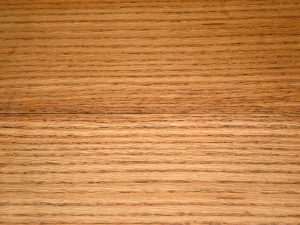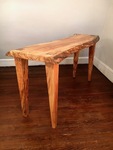We may receive a commission when you use our affiliate links. However, this does not impact our recommendations.

The top was sanded just to 100 grit, the bottom to 600 grit. Then stain was applied and the excess was wiped off.
Every now and then I come across the claim that sanding with very fine-grit sandpaper closes the pores of wood, and this limits the degree a stain can color the wood.
Think about this for a moment. How exactly does this work? How does sandpaper “close” wood pores? I think this claim makes no sense.
But it is true that sanding to finer and finer grits limits the amount of color a stain imparts to the wood, after you wipe off the excess. Is there maybe a better explanation for this, one that is actually quite obvious?
There’s a concept in science called Ockham’s Razor, a weird name so it may be unfamiliar to you. It comes from a Franciscan friar named William of Ockham who lived in the fourteenth century. It has several similar interpretations but the one I like says that the simple explanation for a phenomenon is better than a more complex one because it’s easier to test.
So, how are you going to test the closing of wood pores? Which wood? Early wood or late wood? It seems to me that the simpler explanation is that finer grit sandpapers create finer scratches so less stain color will remain after you wipe off the excess stain. This is easily testable simply by sanding to different grits, applying stain, then wiping off the excess and compare.
So I’m being a little snide, but maybe it will help to eliminate the pore-closing explanation.
- Six Myths About Wood FinishingThe time and cost of materials you invest in any woodworking project can make the final finishing stage a nerve-racking one. You want to get it right, and there are a lot of wild ideas out there [...]Read more
Here are some supplies and tools we find essential in our everyday work around the shop. We may receive a commission from sales referred by our links; however, we have carefully selected these products for their usefulness and quality.











I started woodworking around 1964 and do not feel your 100% correct in your assumption. Please allow me to explain, viewed under a microscope the surface of a roughly sanded surface would have many deep scratches allowing stain to penetrate the surface. Also a fine sanded surface end grain repels stain, with or without wiping off the stain. Another proof of my sanding, staining theory is, don’t sand at all, the surface of a torn fiber will act like blotting paper whilst an inline fiber will repel stain. Your explanation is obviously somewhat correct but not wholly correct. Take it from me, a finely sanded work of art repels stain with or without a final wipe clean.
Seems like this would apply to pigment-based stains, but not dye-based, right?
You constantly destroy my deep held beliefs. Thanks for doing the hard work.
Do your findings also relate to oil absorption?
Recently I oiled a pecan kitchen tool handle after sanding to 300 or so grit. Mineral oil absorbed fine and color was good. After that I sanded with higher grits because I’m a masochist or don’t know any better and was satisfied with the feel of the handle. Later, I decided I needed to sand off a lump on the handle. Went straight through to 1000+ grit. Naturally this exposed an oil-unabsorbed patch of wood that needed to be re-oiled. However, no matter how long I dunked that handle in oil it never matched the color of the rest of the handle. Did I clog the pores or whatever with the high grit? Straight up mineral oil.
Where’s the rest of the article? Did the author get around to performing the experiment? What were the results? What’s the argument againt *both* issues causing less stain on the wood? A possible answer to the author’s question at the beginning of the article is that maybe sanding with too fine of a grit creates wood particles to get stock into the pores of the wood, causing less stain to get in.